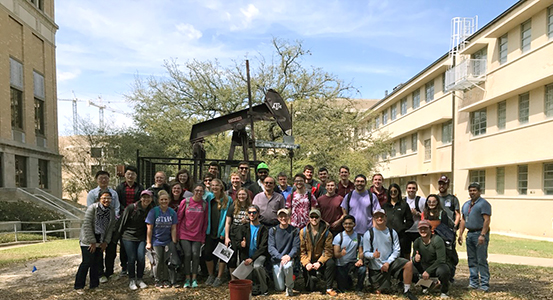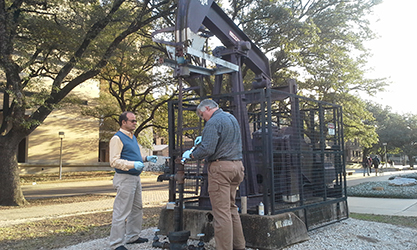
If you walk down Ross Street on the Texas A&M University campus, you might think the small pump jack positioned near the south side of the Doherty Building is an art project when you first pass by, but this is no statue. It is a working piece of equipment on an actual well site, and it has an interesting history.
The Doherty Building on the corner of Spence and Ross streets housed the Harold Vance Department of Petroleum Engineering before it moved to its current location in the Richardson Building in 1991. The pump jack nearby is part of the hands-on educational experiences required of future petroleum engineers. It is also a visible symbol of academic need, the generosity of former students in industry, and the volunteer labor of petroleum engineering students.
In late 1983, three test wells were proposed by then faculty member Dr. J.T. Rollins. He based his proposal on the idea that water wells would be an excellent means of teaching petroleum engineering students how well systems worked. In the winter break of 1983-84, a single well was drilled with student labor using a shallow drilling rig the department owned at that time. Lufkin Industries (now part of GE Oil and Gas) donated all of the original pumping and monitoring related equipment. Once completed, the well came to be known as Laboratory Test Well #3, but has adopted the nickname of Aggie Well No. 1 over the years.
Aggie Well No. 1 was drilled to a depth of approximately 500 feet and a “dual completion” was installed. This means the well has traditional 2 3/8-inch tubing for a sucker rod pump and 1 1/4-inch tubing as a “dead string” for lowering a pressure measurement device. In late March 1984, a device was lowered and the well water samples were tested. The water was determined to be suitable for watering the grass and for discharge in the storm drains, if needed. The well was considered a success and Aggie Well No. 1 was designated to a “pump test” well for pressure transient analysis.
There were a few quirks in its construction. Normal pump jacks are quite a bit bigger than the unit used for Aggie Well No. 1, but the unit had to fit the allocated space on campus. It looks over-muscled for its size because the rod load is minimal compared to the weights on the arms, but these were the smallest sized weights Lufkin Industries had for this particular unit at the time. The unit featured a variable-speed controller that allowed the sucker rod pumping unit to have variable speeds, but the controller was never used extensively because the unit is mainly for academic purposes.
In 1989, it was found the water zone at 425 feet was capable of delivering at least 30 gallons per minute. Since that time, the well has been used for pressure transient test sequences (i.e., drawdown and buildup tests). Petroleum engineering students measure the water level by using a resistivity device in the dead string (which is open at the bottom and reflects the overall fluid level in the well).
Dr. Tom Blasingame, Robert L. Whiting Professor, has used the well for his pressure transient testing course since the early 1990s. He and Dr. Ibere Alves, professor of engineering practice, keep the old pump in prime shape. Alves uses the well for demonstrations in his classes. This summer Alves will work with Lufkin Industries to restore and upgrade some of the equipment, since the company continues to provide the goods and services needed to maintain and enhance the unit.

(Alves and Blasingame performing maintenance on Aggie Well No. 1)
In addition to pressure transient tests and demonstrations, Aggie Well No. 1 was also used as a test case for the sucker rod pump system installed on the well. This means the well was “load-tested” many times for the Production Engineering Lab using a portable load cell and testing kit, also provided by Lufkin Industries.
For over 30 years, countless students have used Aggie Well No. 1 to learn more about well systems and operations, just as Rollins envisioned. Hopefully it will continue to do so for another 30 years.
So next time you pass by the Doherty Building, take a look at Aggie Well No. 1 and remember the teamwork behind it: faculty, former students and current students – all striving to improve knowledge and produce better students. That collaboration is what makes Texas A&M a great place to learn.